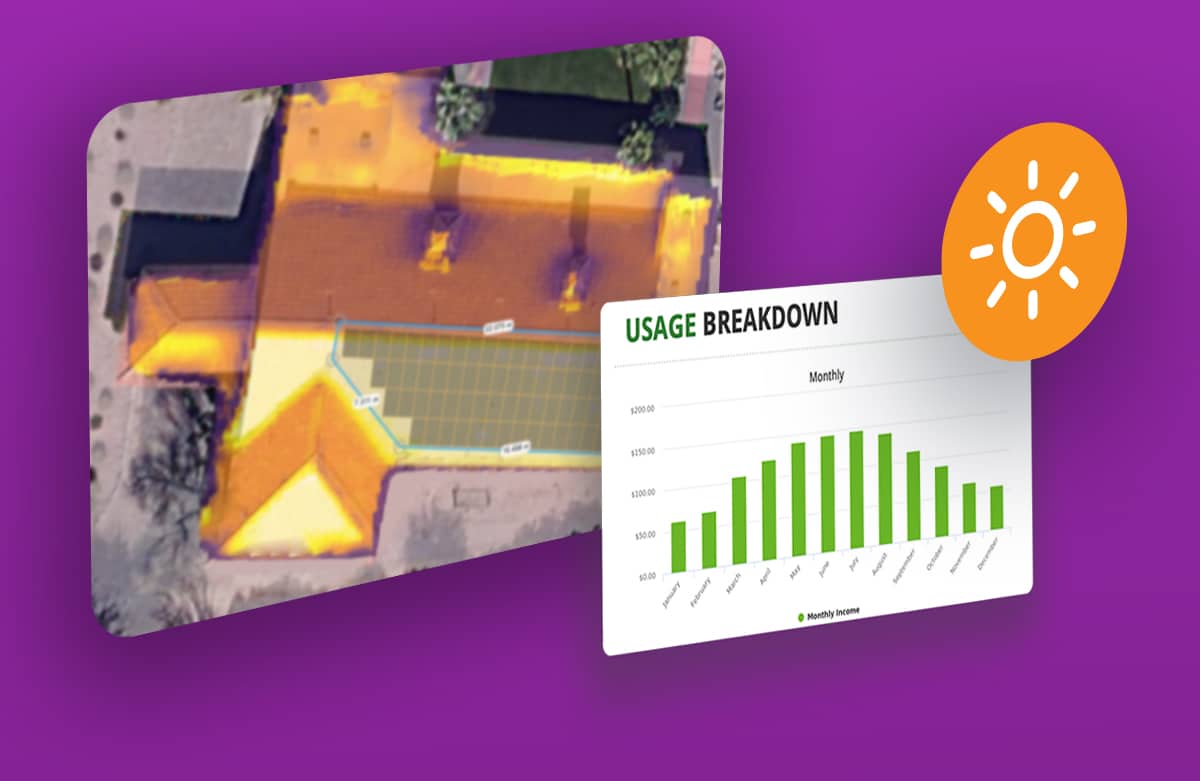
In our previous post, we focused on how to handle consumer misconceptions and increase solar sales. Today, we’ll be taking a look at the advantages of integrating shading information in your proposals.
As a solar installer, you know that competition can be fierce and potential buyers can be extremely choosy when deciding on an installer. In this article, we’ve outlined a few ways that incorporating shading information in your proposals can save you time and boost your sales.
Firstly, let’s go over the basics of Solargraf’s one-click Shading Analysis feature: This technology works by combining Google Project Sunroof’s map imagery and machine learning to determine the solar potential of the roof you are working on in Solargraf. You can then use this information to present a proposal and a solar panel design that is fully optimized for the amount of sun exposure your client’s roof gets all year.
Now, let’s dive in to how you can use this feature to your advantage and close more sales with Solargraf all while saving precious time.
1) Make your design easy for anyone to understand.
While there are many technical products and solutions available for installers to use to mitigate their system shading losses out there, it’s not always easy to communicate this to your clients.
Not everyone understands what a bypass diode is and your average person might not know anything about inverters or microinverters either. While it may be your job to answer your prospect’s questions and help them understand all the components of their solar systems, having simple visuals can work wonders for their understanding.
Has it ever happened that a homeowner has asked you to quote them for a system to be installed on the North-facing side of their roof because that side is the least visible from the street or their neighbors? It could be difficult to convince someone that their system, while hidden from view will most likely be a waste of money for them.
The One-Click Solargraf Shading Analysis tool will help your leads to understand and visualize the reasoning behind why you’ve designed their system the way that it is.
By being able to overlay the shading image directly over your drawing on the proposal, homeowners will be able to see the full picture and understand that the panels are placed in the most efficient configuration possible. This also gives them the best estimation of their savings which could be a major selling point for you as it increases your customer’s trust in your expertise and gives them the best price solution possible.
2) No designer required.
Forget hiring a designer or spending time and energy training your team on how to use a solar design tool that is most likely more difficult to use than it needs to be. Solargraf’s automatic Shading Analysis feature is the simplest, most reliable way to get accurate, compliant shading information on the market.
How do you use it, you ask? Well, it’s as easy as clicking the yellow button on the drawing page, aligning the shading imagery over your drawing and clicking “calculate”. Solargraf will then show you a full report on your chosen roof, guiding your solar design and allowing you to come up with the best possible placement of your system. You can then add this information to your quotes to pass along to your leads.
You know that a roof should be getting good southern exposure from at least 9:00 am to 3:00 pm every day. The trick is figuring this out from a simple image of a roof on a map.
Using an automated tool to identify the parts of the roof that actually fit these criteria helps to take the guesswork out of your solar designs by showing you exactly which parts of the roof get the most sun throughout the day. Once the panels are on the roof and the shading has been calculated, you can also generate the monthly solar access percentage on a graph
3) Help your leads pull the trigger.
Have you ever seen a home that is so perfect for a PV system that you know you just have to convince whoever lives there to throw some panels on their roof?
Even though the cost of solar has decreased significantly over the past few years, buying a system is still a huge investment for most people. This means that you really need to pull out all your clever solar marketing tricks to get your prospects to sign on the dotted line.
Shading information and accurate savings calculations are extremely helpful in making the sale. Homeowners will be able to see exactly how much they’ll be saving when their solar panel design is optimized for how much sun their roof gets all day. If you know a roof is ideal for solar, make sure the homeowner knows too. Using a design software that includes this information is sure to impress anyone looking to save money.
4) Don’t waste time on site.
Gone are the days of visiting every single home and selling solar door to door before ever coming up with any concrete information and numbers for your leads because the only data you have is an image of the roof off Google Maps and a rough idea of how many panels might fit up there.
Incorporating automated shading calculations in your proposals means that you have more accurate information with less time spent.
No more trying to schedule your team and coordinate with homeowners just to get to the house and take a look at the sun exposure to the roof yourself. Use the Shading Analysis tool and impress them before you even meet them with a full quote and system design that might only need a few small tweaks made based on the homeowner’s preferences.
More time at the office means more time to create quotes for even the coldest of leads, increasing your chances of making more sales.
In closing
Having an eye-catching and informative quote ready for all your prospects at the click of a button can be the one detail that sets you apart from your competition in this solar saturated landscape. Now that you’ve seen the ways including a Shading Analysis can increase your sales, book a demo today to give it a try for yourself, or take a look at other Solargraf features built to help you save time and grow your business here!



 United States
United States Germany/Austria
Germany/Austria Brazil
Brazil Netherlands
Netherlands